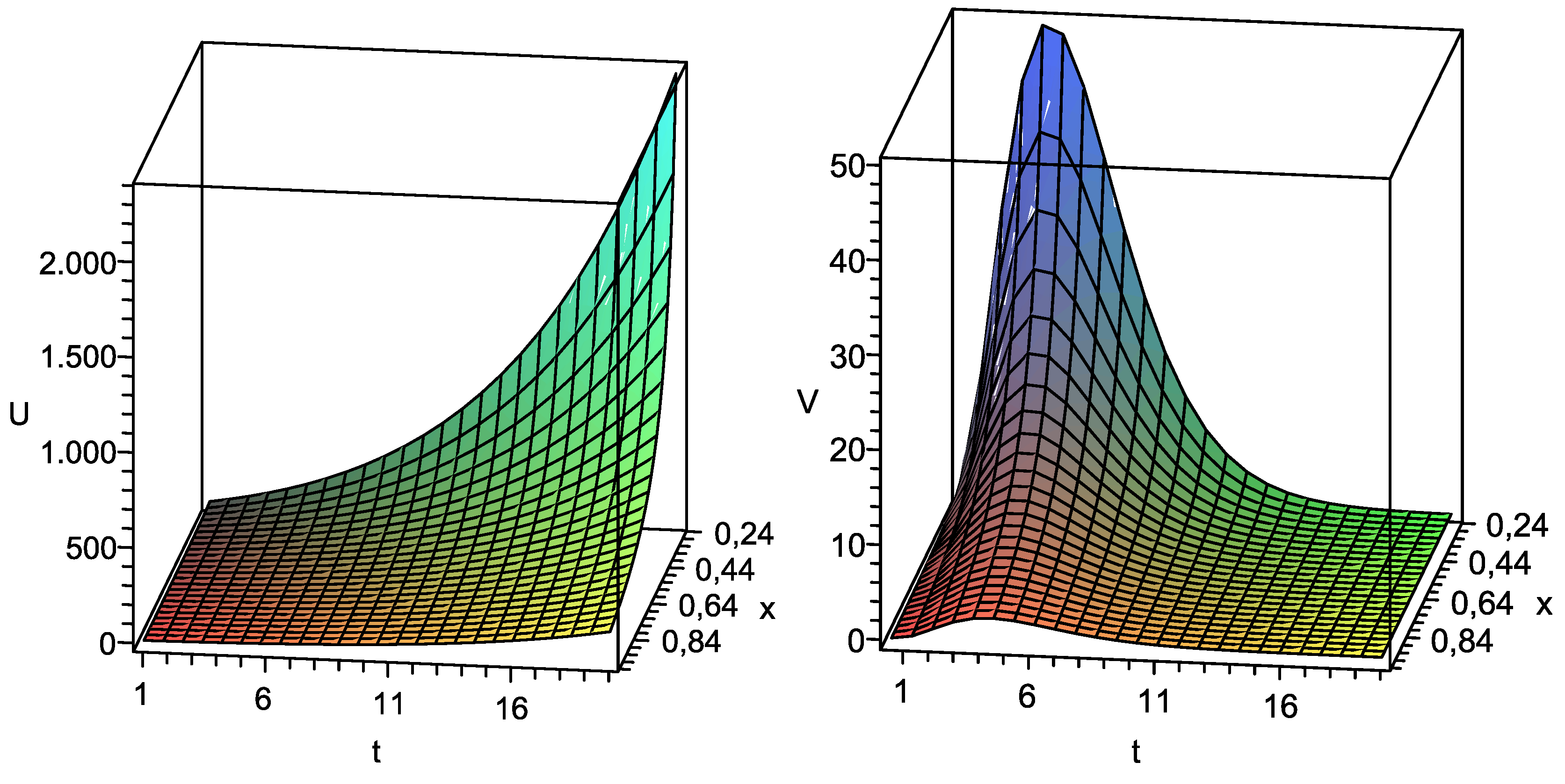Lie Symmetry of the Diffusive Lotka–Volterra System with Time-Dependent Coefficients
Abstract
:1. Introduction
2. Main Results
3. Exact Solutions of the DLV System
4. Conclusions
Acknowledgments
Conflicts of Interest
References
- Volterra, V. Variazioni e fluttuazioni del numero d’individui in specie animali conviventi. Mem. Acad. Lincei 1926, 2, 31–113. [Google Scholar]
- Britton, N.F. Essential Mathematical Biology; Springer: Berlin, Germany, 2003. [Google Scholar]
- Lotka, A.J. Undamped oscillations derived from the law of mass action. J. Am. Chem. Soc. 1920, 42, 1595–1599. [Google Scholar] [CrossRef]
- Murray, J.D. Mathematical Biology II; Springer: Berlin, Germany, 2003. [Google Scholar]
- Cherniha, R.; Davydovych, V. Nonlinear Reaction-Diffusion Systems—Conditional Symmetry, Exact Solutions and Their Applications in Biology; Lecture Notes in Mathematics; Springer: Berlin, Germany, 2017; ISBN 978-3-319-65465-2. [Google Scholar]
- Hou, X.; Leung, A.W. Traveling wave solutions for a competitive reaction diffusion system and their asymptotics. Nonlinear Anal. Real World Appl. 2008, 9, 2196–2213. [Google Scholar] [CrossRef]
- Leung, A.W.; Hou, X.; Feng, W. Traveling wave solutions for Lotka–Volterra system re-visited. Discret. Contin. Dyn. Syst. 2011, 15, 171–196. [Google Scholar] [CrossRef]
- Cherniha, R.; Dutka, V. A diffusive Lotka–Volterra system: Lie symmetries, exact and numerical solutions. Ukr. Math. J. 2004, 56, 1665–1675. [Google Scholar] [CrossRef]
- Rodrigo, M.; Mimura, M. Exact solutions of a competition-diffusion system. Hiroshima Math. J. 2000, 30, 257–270. [Google Scholar]
- Hung, L.-C. Exact traveling wave solutions for diffusive Lotka Volterra systems of two competing species. Jpn. J. Ind. Appl. Math. 2012, 29, 237–251. [Google Scholar] [CrossRef]
- Cherniha, R.; Davydovych, V. Conditional symmetries and exact solutions of the diffusive Lotka Volterra system. Math. Comput. Model. 2011, 54, 1238–1251. [Google Scholar] [CrossRef]
- Cherniha, R. Lie symmetries of nonlinear two-dimensional reaction-diffusion Systems. Rep. Math. Phys. 2000, 46, 63–76. [Google Scholar] [CrossRef]
- Hou, Z.; Lisena, B.; Pireddu, M.; Zanolin, F. Lotka–Volterra and Related Systems: Recent Developments in Population Dynamics; Walter de Gruyter: Berlin, Germany, 2013; ISBN 978-3-11-026951-2. [Google Scholar]
- Bao, X.X.; Li, W.T.; Wang, Z.C. Time periodic traveling curved fronts in the periodic Lotka–Volterra competition-diffusion system. J. Dyn. Differ. Equ. 2017, 29, 981–1016. [Google Scholar] [CrossRef]
- Hetzer, G.; Shen, W. Convergence in almost periodic competition diffusion systems. J. Math. Anal. Appl. 2001, 262, 307–338. [Google Scholar] [CrossRef]
- Hutson, V.; Mischaikow, K.; Poláčik, P. The evolution of dispersal rates in a heterogeneous time-periodic environment. J. Math. Biol. 2001, 43, 501–533. [Google Scholar] [CrossRef] [PubMed]
- Struk, O.O.; Tkachenko, V.I. On impulsive Lotka–Volterra systems with diffusion. Ukr. Math. J. 2002, 54, 629–646. [Google Scholar] [CrossRef]
- Ovsiannikov, L.V. The Group Analysis of Differential Equations; Academic: New York, NY, USA, 1982. [Google Scholar]
- Ovsiannikov, L.V. Group relations of the equation of non-linear heat conductivity. Dokl. Akad. Nauk SSSR 1959, 125, 125492–125495. [Google Scholar]
- Zhdanov, R.Z.; Lahno, V.I. Group classification of heat conductivity equations with a nonlinear source. J. Phys. A Math. Gen. 1999, 32, 7405. [Google Scholar] [CrossRef]
- Kingston, J.G. On point transformations of evolution equations. J. Phys. A Math. Gen. 1991, 24, L769–L774. [Google Scholar] [CrossRef]
- Kingston, J.G.; Sophocleous, C. On form-preserving point transformations of partial differential equations. J. Phys. A Math. Gen. 1998, 31, 1597–1619. [Google Scholar] [CrossRef]
- Gazeau, J.P.; Winternitz, P. Symmetries of variable coefficient Korteweg-de Vries equations. J. Math. Phys. 1992, 33, 4087–4102. [Google Scholar] [CrossRef]
- Cherniha, R.; Davydovych, V.; King, J.R. Lie symmetries of nonlinear parabolic-elliptic systems and their application to a tumour growth model. ArXiv, 2017; arXiv:1704.07696. [Google Scholar]
- Cherniha, R.; King, J.R. Non-linear reaction diffusion systems with variable diffusivities: Lie symmetries, ansatze and exact solutions. J. Math. Anal. Appl. 2005, 308, 11–35. [Google Scholar] [CrossRef]
- Cherniha, R.; Serov, M.; Rassokha, I. Lie symmetries and form preserving transformations of reaction-diffusion-convection equations. J. Math. Anal. Appl. 2008, 342, 1363–1379. [Google Scholar] [CrossRef]
- Vaneeva, O.O.; Popovych, R.O.; Sophocleous, C. Enhanced group analysis and exact solutions of variable coefficient semilinear diffusion equations with a power source. Acta Appl. Math. 2009, 106, 1–46. [Google Scholar] [CrossRef]
- Cherniha, R.; Serov, M.; Pliukhin, O. Nonlinear Reaction-Diffusion-Convection Equations: Lie and Conditional Symmetry, Exact Solutions and Their Applications; CRC Press: Boca Raton, FL, USA, 2018; ISBN 9781498776172. [Google Scholar]
- Arrigo, D.J. Symmetry Analysis of Differential Equations: An Introduction; John Wiley and Sons: Hoboken, NJ, USA, 2015; ISBN 9781118721445. [Google Scholar]
- Bluman, G.W.; Cheviakov, A.F.; Anco, S.C. Applications of Symmetry Methods to Partial Differential Equations; Springer: New York, NY, USA, 2010; ISBN 978-0-387-68028-6. [Google Scholar]
- Olver, P.J. Applications of Lie Groups to Differential Equations; Springer: Berlin, Germany, 1986; ISBN 978-1-4684-0274-2. [Google Scholar]
- Nie, L.; Teng, Z.; Hu, L.; Peng, J. Permanence and stability in non-autonomous predator-prey Lotka–Volterra systems with feedback controls. Comput. Math. Appl. 2009, 58, 436–448. [Google Scholar] [CrossRef]
| d | Reaction Terms | Basic Operators of Maximal Algebra of Invariance | |
|---|---|---|---|
| 1. | |||
| 2. | 0 | ||
| 3. | |||
| 4. | |||
| 5. | 0 | ||
| 6. | 0 | ||
| 7. | 0 | ||
| 8. | |||
| 9. | |||
| 10. | |||
| 11. | |||
| 12. | |||
| 13. | |||
| Reaction Terms | Basic Operators of Maximal Algebra of Invariance | |
|---|---|---|
| 1. | ||
| 2. | ||
| 3. | ||
| 4. | ||
| 5. | ||
| 6. | ||
| 7. | ||
| 8. | ||
| 9. | ||
© 2018 by the author. Licensee MDPI, Basel, Switzerland. This article is an open access article distributed under the terms and conditions of the Creative Commons Attribution (CC BY) license (http://creativecommons.org/licenses/by/4.0/).
Share and Cite
Davydovych, V. Lie Symmetry of the Diffusive Lotka–Volterra System with Time-Dependent Coefficients. Symmetry 2018, 10, 41. https://doi.org/10.3390/sym10020041
Davydovych V. Lie Symmetry of the Diffusive Lotka–Volterra System with Time-Dependent Coefficients. Symmetry. 2018; 10(2):41. https://doi.org/10.3390/sym10020041
Chicago/Turabian StyleDavydovych, Vasyl’. 2018. "Lie Symmetry of the Diffusive Lotka–Volterra System with Time-Dependent Coefficients" Symmetry 10, no. 2: 41. https://doi.org/10.3390/sym10020041





